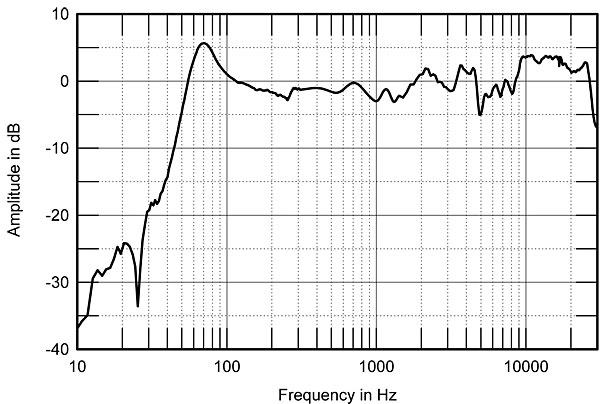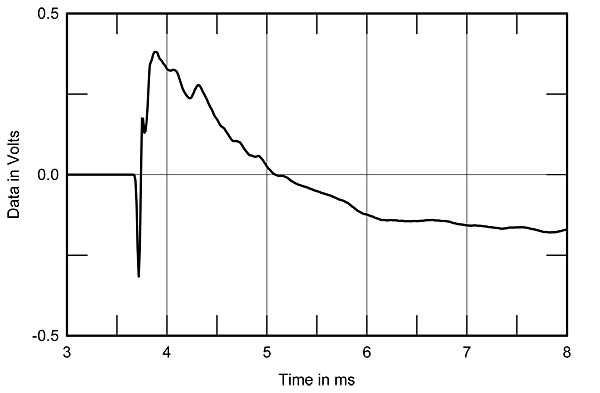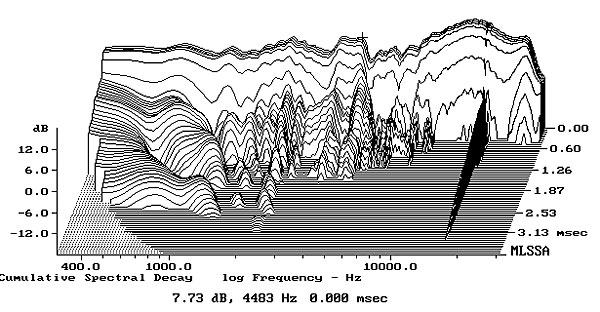| Columns Retired Columns & Blogs |
Nola Contender loudspeaker Measurements
Sidebar 3: Measurements
Designer Carl Marchisotto recommended that I measure the Nola Contender on an axis 37" above the ground with the speaker sitting on its supplied feet, which raise it sufficiently to allow its downward-firing port to operate correctly. The Contender's B-weighted sensitivity on this axis, assessed with DRA Labs' MLSSA system and a calibrated DPA microphone, was 89.5dB/2.83V/m, which is within experimental error of the specified 90dB and slightly above the norm. The Contender should reach satisfyingly high levels with moderately powerful amplifiers. Reinforcing this high sensitivity, the electrical impedance (fig.1) remains above 6 ohms across almost the entire audioband, and the electrical phase angle is low everywhere except in the low bass. The Contender will therefore be an easy speaker for the partnering amplifier to drive.

Fig.1 Nola Contender, electrical impedance (solid) and phase (dashed). (2 ohms/vertical div.)
There is a suspicious-looking wrinkle in the impedance traces around 230Hz. However, when I investigated the vibrational behavior of the enclosure panels, I found only low-level resonant behavior at this frequency (fig.2). What I did find was that the walls of the upper half of the cabinet were being pumped at the tuning frequency of the upper port, which loads the midrange unit. This pumping, too, can be seen in fig.2. Given the relatively large surface area affected by this behavior, I would have expected there to be some audible consequences, though it's fair to point out that Bob Reina found nothing amiss in the Contender's low-frequency clarity. The lower half of the cabinet was relatively inert.

Fig.2 Nola Contender, cumulative spectral-decay plot calculated from output of accelerometer fastened to side panel level with the midrange unit (MLS driving voltage to speaker, 7.55V; measurement bandwidth, 2kHz).
The acoustic outputs of the drive-units are shown in fig.3. The midrange unit (red trace) actually extends very low in frequency, not rolling off until below 80Hz. The woofer (brown trace) is overall about 4dB less sensitive than the midrange unit, and covers a narrow passband (50–75Hz), though there is some return in level in the very low bass and the woofer's midrange output is shelved down rather than rolled off. The green trace in fig.3 is the nearfield output of the upper, rear-facing port, which loads the midrange unit. While the midrange unit has a sharply defined notch in its output at 52Hz, the port's response peaks a little higher in frequency, and has a second peak coincident with that of the unit below the port resonance. Both the midrange unit and its port roll off with ultimate 24dB/octave slopes, due to the crossover's high-pass filter.

Fig.3 Nola Contender, nearfield responses of midrange unit (red trace), woofer (brown), upper port (green), bottom port (blue).
The blue trace in fig.3 shows the response of the downward-firing port, which loads the woofer. As with the midrange port, the primary peak in this port's output doesn't coincide with the minimum-motion notch but is higher in frequency, with a second peak at lower frequencies. Note the low-level peak at 230Hz in the bottom port's output; this coincides with a slight discontinuity in the woofer's output at the same frequency. The woofer and its port roll off with the usual 12dB/octave slopes.
The left-hand side of fig.4 shows how these nearfield responses sum at a nominal farfield microphone position. The coincidence of the outputs of the two ports with the peak in the woofer's output gives rise to a peak in the midbass. Although the nearfield measurement technique exaggerates this by 6dB, I would still expect it to make the speaker sound a little ponderous—though it would also add, as BJR said, "a sense of thundering solidity and bottom-end anchor." The trade-off of this staggered tuning of the midrange and woofer ports is a faster rolloff below 60Hz than you might expect from a speaker this large. Note also the notch in the summed nearfield outputs at the frequency of the small resonance in the bottom port's output.

Fig.4 Nola Contender, anechoic response on listening axis at 50", averaged across 30° horizontal window and corrected for microphone response, with complex sum of nearfield midrange, woofer, and port responses plotted below 300Hz.
The right-hand side of fig.4 shows the Contender's farfield response, averaged across a 30° horizontal window on an axis 37" above the floor. The balance is relatively flat, though there is an excess of energy in the mid-treble and above 9kHz. I suspect that the former, because it is in the region where the ear is most sensitive, aids the sensation of detail produced by the Contender. The latter would make the sound a bit top-heavy, though this top-octave excess is actually balanced by the fact that the Nola speaker's horizontal dispersion in the same region is very narrow (fig.5). Though there are some slight ridges and dips to the speaker's sides, the Contender's off-axis behavior is relatively even. In the vertical plane (fig.6), a suckout develops in the upper crossover region as you move up to the tweeter axis and above. Sit much lower than 37" and the excess in the presence region increases in level. You need to sit on the intended axis to get the best sound from this speaker.

Fig.5 Nola Contender, lateral response family at 50", normalized to response on listening axis, from back to front: differences in response 90–5° off axis, reference response, differences in response 5–90° off axis.

Fig.6 Nola Contender, vertical response family at 50", normalized to response on listening axis, from back to front: differences in response 15–5° above axis, reference response, differences in response 5–10° below axis.
The Contender's step response on this axis (fig.7) shows that the tweeter is connected in inverted acoustic polarity, the midrange in positive polarity, and that the optimal integration of their outputs will actually occur a little lower than 37" from the floor. (The slight glitch in the positive-going rise in the midrange unit's output is due to the tweeter's output arriving at the microphone a little before the midrange unit's.) Although it can't be seen in this graph, the woofer's output is in the opposite polarity to the midrange unit's. The start of the woofer's step coincides with the negative-going undershoot of the midrange step's decay. The Contender's farfield, cumulative spectral-decay plot (fig.8) reveals an impressively clean initial decay, though ridges of delayed resonant energy are apparent at the top of the midrange unit's passband, coincident with the excess of presence-region energy.

Fig.7 Nola Contender, step response on listening axis at 50" (5ms time window, 30kHz bandwidth).

Fig.8 Nola Contender, cumulative spectral-decay plot on listening axis at 50" (0.15ms risetime).
The Nola Contender has much going for it, measurement-wise. However, the low-frequency behaviors of its midrange unit and woofer and their ports have me puzzled. I fail to see the sonic benefit of this complex arrangement, and can't help wondering if a more orthodox design using the same drive-units would produce greater low-frequency extension.—John Atkinson
- Log in or register to post comments




































